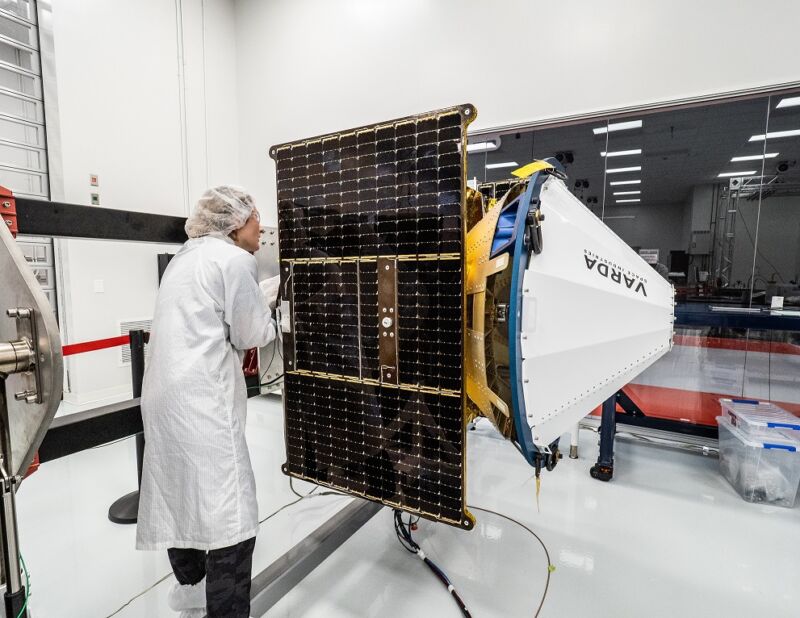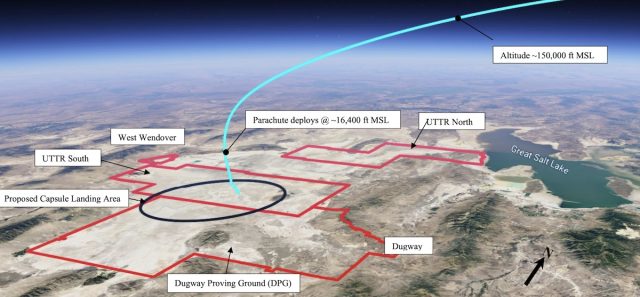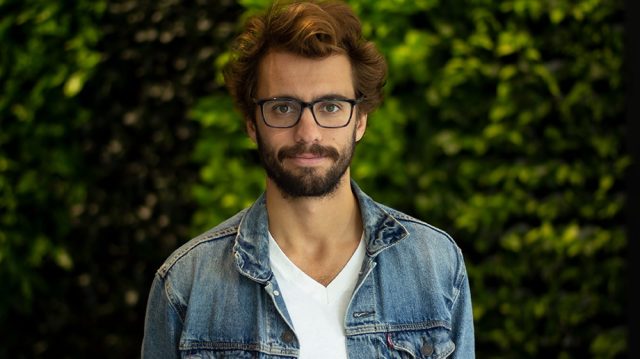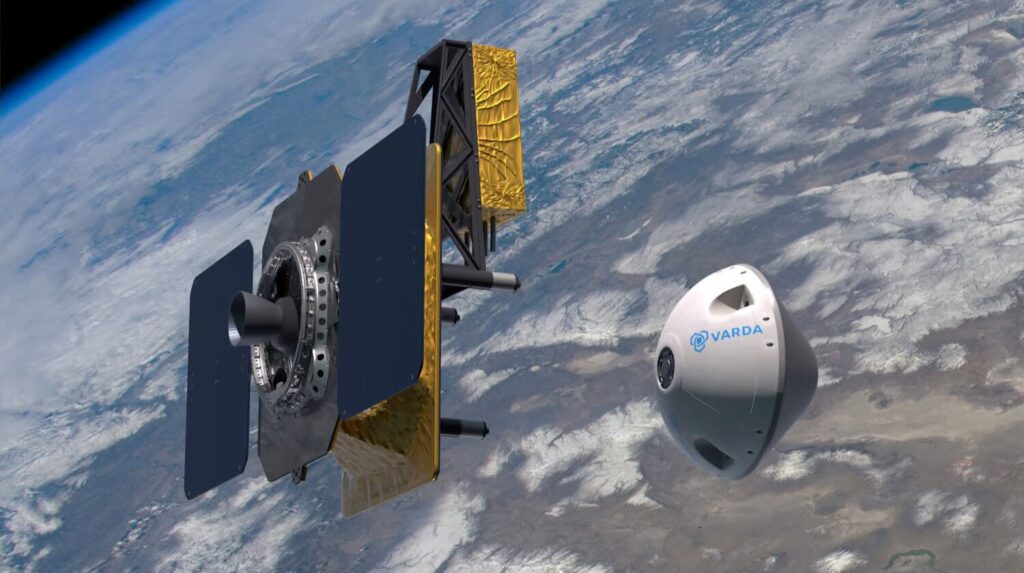One more big test remains for Varda's first-of-its-kind "space factory."

Varda Space's first "Winnebago" spacecraft, called W-Series 1, before its launch June 12.
Rocket Lab
The co-founder of California-based startup Varda Space Industries says his company’s first space mission—a miniature lab that has grown crystals of the drug ritonavir in orbit—is on track to end in the coming weeks with a first-of-its-kind re-entry and landing in Utah.
Varda’s spacecraft launched June 12 as part of a rideshare mission on a SpaceX Falcon 9 rocket, then completed several weeks of checkouts before starting a 27-hour drug-manufacturing experiment last week. When ground controllers gave the go-ahead, the mini-lab began growing crystals of ritonavir, a drug commonly used to treat HIV.
The experiment’s 27-hour run was completed on June 30, and data downlinked from the spacecraft showed everything went well.
“For the first time ever, orbital drug processing happened outside of a government-run space station,” Varda tweeted. “This is our first step in commercializing microgravity and building an industrial park in LEO (Low Earth Orbit).”
“Space drugs have finished cooking baby!” tweeted Delian Asparouhov, Varda’s co-founder.
Asparouhov, who established Varda in 2020 with former SpaceX engineer Will Bruey and scientist Daniel Marshall, said Friday he is thrilled with the progress of the demonstration mission.
“One of the critical parts of pharmaceutical processing is being able to maintain appropriate temperature ranges for extended periods of time,” Asparouhov told Ars. “It was exactly per our expectations, which is really great to see.”
Varda is planning a sequence of satellite missions. The spacecraft currently in orbit is the first of Varda’s Winnebago series, designed to bring pharmaceutical research specimens back to Earth for laboratory analysis and eventual commercial exploitation.
The roughly 660-pound (300-kilogram) satellite was built in partnership with Rocket Lab, which supplied a solar-powered carrier module, or bus, providing electricity, communications, propulsion, and attitude control. Varda built a nearly 3-foot-diameter (1-meter) re-entry capsule mounted to the side of Rocket Lab’s satellite platform.

This chart from an FAA environmental assessment shows the expected trajectory of Varda's
re-entry vehicle as it approaches the Utah Test and Training Range.
Federal Aviation Administration
Sometime in the next few weeks, Rocket Lab’s ground team will uplink a command to fire the spacecraft’s thrusters for a braking maneuver to drop the satellite out of orbit, setting it on a course to plunge back into the atmosphere and target a landing at the US military’s Utah Test and Training Range southwest of Salt Lake City.
Varda’s nearly 200-pound re-entry capsule will separate from its carrier craft before re-entry. An ablative carbon-based heat shield material developed by NASA will protect the capsule from scorching hot temperatures as it streaks through the atmosphere, approaching the desert landing zone from the north. Then, if all goes according to plan, the re-entry vehicle will deploy a 6.2-foot-diameter (2.1-meter) main parachute to slow its velocity for a relatively gentle landing.
FAA license pending
Varda is now working with Rocket Lab, the Federal Aviation Administration, and the military to schedule the mission’s return to Earth. The landing window opens July 17, but the actual return date is likely to move to later this month, he said.
“Now, we’re more in the phase of getting everything lined up between the satellite performing the deorbit burn, as well as the regulatory partners helping with airspace control, all the way down to the military resources that will be helping us with the actual retrieval on the range,” Asparouhov said in an interview.
Varda and its partners completed a rehearsal for the recovery in Utah in early June, about a week before the mission’s launch.
One item on Varda’s checklist that hasn’t been completed yet is the FAA’s approval of a commercial re-entry license application. Steven Kulm, an FAA spokesperson, confirmed Friday that the FAA has not yet issued a re-entry license to Varda.
The FAA ensures commercial launch and re-entry operations don’t endanger the public. The FAA has licensed 53 commercial launches so far in 2023 for SpaceX, Rocket Lab, Virgin Galactic, Virgin Orbit, Relativity Space, and ABL Space Systems. But it has only licensed five re-entries this year, all for SpaceX’s Dragon crew and cargo missions returning from the International Space Station.
Once its license is approved, Varda Space will become just the third company to receive a commercial FAA re-entry license and the first under streamlined commercial spaceflight regulations known as Part 450.
“We would be the first to operate within this new regulatory regime (for a re-entry),” Asparouhov said.
The FAA has worked for years to ease the impact of commercial space launches on air traffic over the United States. With launches becoming a regular occurrence at places like Cape Canaveral, Florida, air traffic controllers have reduced the amount of airspace restricted to commercial air traffic around spaceports. That results in fewer flights that have to be re-routed to avoid a launch hazard area.
Asparouhov said his company has worked with the FAA since its founding in 2020.
“As the United States builds this capability to do regular low-cost re-entry over land, how does that interface with commercial air traffic over the United States?” Asparouhov said. “How does (commercial air traffic) interact with regularly re-entering capsules? We’re really excited to forge that path forward with the FAA.”
Blazing a new trail back to Earth
SpaceX’s Dragon and Boeing’s Starliner are the two other commercial re-entry vehicles that have flown back to Earth from space. Both are significantly larger and more complex than Varda's vehicle.
“It’s a very different type of re-entry capsule. If you think about it, both Dragon and Starliner, these are vehicles that are $100 million-plus, minimum, to build, and billion-dollar-plus total programs. These are meant to carry humans, have active control, fully pressurized environments,” Asparouhov said. “We are effectively the polar opposite type of re-entry vehicle. If those are luxurious limousines, we’re building like 1986 Toyota Corolla that is meant to be less than a million bucks a pop, quickly refurbished, and then shot right back into space.”

Delian Asparouhov, co-founder of Varda Space Industries.
Founders Fund
“Ultimately as you start to get to a large economy in orbit, you do need extremely low-cost, regularly flown re-entry vehicles, and I think that’s something that’s a core competency of Varda,” Asparouhov said.
A second experimental flight of Varda’s orbital “factory” is scheduled for launch later this year.
Varda Space has raised $53 million to date from investors and venture capital firms. Asparouhov is a partner at Founders Fund, a San Francisco-based venture capital firm founded by billionaire Peter Thiel, and one of the early backers of Varda.
The company was founded to pursue a market for off-planet manufacturing. It’s not the first company geared toward this market, but Varda is different in that it is focusing on flying standalone satellites rather than working on the International Space Station. The company’s founders identified pharmaceuticals, semiconductors, and fiber optic manufacturing as the products that could most benefit from in-space manufacturing.
There’s a long waiting list for payloads and experiments to fly to the space station. Perhaps more importantly, there’s a limited capacity to return cargo from the station to Earth, a capability almost exclusively provided by SpaceX resupply missions flying to and from the orbiting research lab about three times per year.
It often takes 12 to 18 months for an experiment to be approved to fly on the space station. Varda aims to cut that time in half, according to Asparouhov.
Source





3175x175(CURRENT).thumb.jpg.b05acc060982b36f5891ba728e6d953c.jpg)

Recommended Comments
There are no comments to display.
Join the conversation
You can post now and register later. If you have an account, sign in now to post with your account.
Note: Your post will require moderator approval before it will be visible.